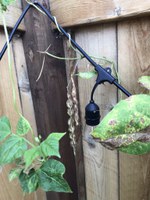Dakota Gardener: Squirreling Away Vegetable Seeds
(Click an image below to view a high-resolution image that can be downloaded)
By Carrie Knutson, NDSU Extension Agent, Grand Forks County
Last fall, I watched the local squirrel as he or she stashed away seeds from our bird feeder for the winter. Imitating the squirrel’s frugal behavior, I am going to save some garden seeds for next year. If you had a hard time finding seeds this past year, you might feel the need to do the same.
What seeds can you save? You can save any seed you want, but the plants that grow next year might not look the same.
Once you know what method of pollination the plant uses and how the original plant was produced you will have a better understanding of how the saved seed will perform.
One method of pollination is self-pollination. Self-pollinated plants are self-fertile and will produce seed from pollen from the same flower on the same plant. Plants grown from these seeds will be almost identically to the parent plant. Examples of self-pollinated plants in the garden are beans, peas, tomatoes and peppers.
Another method of pollination is cross-pollination. Cross-pollinated plants need pollen from another flower, plant and sometimes another variety or cultivar to set seed. Examples of cross-pollinated plants in the garden are cucumbers, melons, squash, pumpkins and gourds. The seeds from these cross-pollinated vegetables may look different from the parent plant.
Sometimes cross- and self-pollinated plants are referred to as open-pollinated plants.
Hybrid plants are developed by carefully controlling pollination. Certain plants are crossed to get desirable growth characteristics. Be careful saving seed from hybrid plants, as your saved seeds will have different characteristics from the parent plant.
Save seed from fruit that is disease free and mature, way past when you would harvest for eating. For example, beans should be dry, brown in color and the seeds should rattle inside. Peppers should be harvested when they are fully ripe and have a wrinkled appearance. Tomatoes should be a deep red color.
Spread the seeds out indoors and let them dry completely before storing. This can take a couple of weeks or more depending on your home’s environment. Do not cut this process short, or you will have moldy seeds!
Seeds can be stored in glass jars in the fridge. Small paper envelopes can be used to keep different seeds separate in the same jar. Remember to label the seeds with their name, variety and the date of harvest. For best germination, seeds should be used within one year. The older the seed, the lower the germination rate.
You may have to do some research on the vegetables or plants that you want to save seed from. In the home garden it is hard to know for sure what pollinated what. So, saving seed can be a gamble. But it is certainly worth a try! Happy gardening!
For more information about gardening, contact your local NDSU Extension agent. Find the Extension office for your county at https://www.ag.ndsu.edu/extension/directory/counties.
NDSU Agriculture Communication – Sept. 7, 2021
Source: Carrie Knutson, 701-780-8229, carrie.knutson@ndsu.edu
Editor: Kelli Anderson, 701-205-9764, kelli.c.anderson@ndsu.edu




